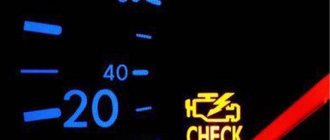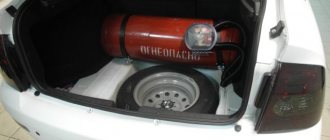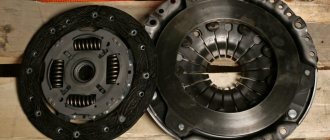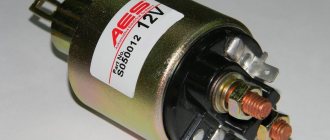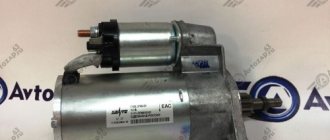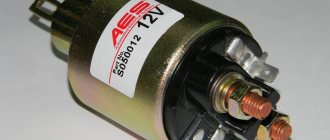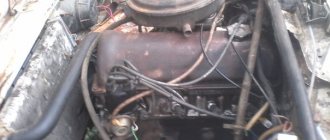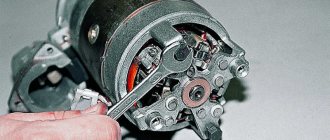A starter is a device that starts the engine when the key is turned in the ignition or the start button is pressed. During operation, the device wears out a lot and ultimately fails.
It is generally accepted that unsuccessful attempts to start the engine are the consequences of a discharged battery. In some cases this is true, and the battery is often discharged due to a malfunction of the generator. However, most often the problem lies with the starter.
When it fails, there are several warning signs.
First news of the problem
It is quite possible that the cause may be damaged wiring or a faulty ignition switch.
If when you turn the key in the ignition switch you hear a click and nothing else happens, then the reason for this may be a discharged battery or the starter itself.
I will not describe the device and principle of operation of the starter; full information on this topic can be studied in the picture below.
Problems with the starting system can be caused by poor maintenance or simply wear and tear. With many modern vehicles equipped with a start/stop button, the load on the starter and battery has increased significantly.
How to check if the starter is taking current
It happens that when the starter is started, the light bulbs powered from the on-board network dim, the volts drop to 10-9.5 - there are signs that there is a current drawdown. This is a very real picture even in the warm season, and it indicates a malfunction of the starter. Many people do not understand how to check the starter if it takes on a lot of starting current, and what, in fact, is the reason for this phenomenon.
Most likely, the reason is the wear of the bushings, which is why the armature begins to touch when the stator rotates. This leads to overheating of the elements and destruction of parts. There is a risk of an interturn short circuit, which can only be detected with a special device - a megger. The bushings must be replaced, and the anchor can be replaced if necessary. Another cause of jamming is sometimes the internal gearbox, which requires lubrication.
If the starter is not working correctly, it is better to contact a trusted specialist who can determine the true cause of the breakdown.
Having summed up all the above tips, it is appropriate to highlight some recommendations from professionals. For example, when several starter parts or even the solenoid relay fail, it is best to purchase and install a completely new starter. Otherwise, the device can be disturbed more than once over all sorts of trifles, not to mention possible inconsistencies in the sizes of some spare parts.
Experts also strongly advise buying new parts rather than repairing old ones, and not giving preference to the cheapest options. Such savings can be completely offset by the negative consequences resulting from early breakdowns.
We will answer your questions for FREE regarding deprivation of rights, road accidents, insurance compensation, driving into the oncoming lane, etc. Daily from 9.00 to 21.00
Moscow and Moscow region
St. Petersburg and Leningrad region
Free call within Russia 8-800-350-23-69 ext.418
The starter continues to operate after the engine starts
When the engine starts and you release the ignition key, the power supply to the traction relay stops and the bendix returns to its original position under the action of a spring.
If power continues to flow, this most likely indicates soldering of the main contacts in the solenoid.
The first thing to do is exclude the battery and generator from the list of possible causes.
Don't forget that the starter only works properly if the battery is fully (or sufficiently) charged.
Therefore, if the engine does not start, try starting it from an external power source using special connecting wires or use a jump starter.
After a successful start, it becomes clear that the problem lies in the electrical system.
When can you move the starter from one car to another?
If the starter manufacturer switched to producing geared models, then direct drive starters can be replaced with geared ones, and vice versa. In this case, it is possible to select even several replacement options for European foreign cars. Starters from different manufacturers that are installed on the same model of machine can be considered analogues.
Today there is a very wide variety of starters produced, and they differ significantly, even though they are outwardly similar. So, they differ in the offset of the bendix, the seating dimensions, the number of teeth on the gears, the size of the teeth, and so on.
Last attempt to start the starter
When trying to turn the key in the ignition switch, one faint click is heard. There is one trick that can help. It may sound strange, but if you press down on the back of the starter while turning the ignition key, the engine can start.
After asking a friend to turn the key in the ignition, press the starter with a hammer. Even if the engine starts, the starter should be repaired or replaced immediately.
Bendix failure
The starter clicks, the electric motor rotates, but the crankshaft does not turn
These are signs of a Bendix malfunction. Remember, its gear should rotate freely in one direction, and jam when you try to turn it in the opposite direction?
So, the cylinders that are in the overrunning clutch are not pressed against the outer race and the gear rotates freely in both directions. This means that when it engages with the flywheel, the Bendix cannot turn the crankshaft as it spins.
This is accompanied by the sounds of a running electric motor. It will work at high speeds, since nothing prevents it from spinning up to maximum values. If the bendix has not yet completely “died”, then this sign of malfunction will appear periodically . That is, today the starter started the engine, but an hour later it may not turn the crankshaft, but simply squeak at maximum engine speed.
Starting a car engine is accompanied by a terrible grinding noise.
This could be for two reasons:
- The Bendix did not engage the flywheel completely.
- The teeth on the gear or flywheel are worn.
In the first case, the bendix jams on the starter shaft. It is enough to disassemble it, clean the splines along which it moves, and lubricate them.
In the second case, only replacing the gear or flywheel. By the way, this malfunction does not appear immediately, but due to long-term use of the starter with poor engagement of the bendix and flywheel. That is, because of the first reason.
Signs of a generator malfunction
Generator faults are not always easy to identify. Some of them (the so-called “floating” faults) are determined only on a special stand.
But if you notice that the headlights have become dimmer while the engine is running, and that extraneous noise interferes with the normal sound of the running engine or that the battery is quickly discharged, then it’s time to contact the experts. Because it is better to prevent a malfunction by repairing the generator in a timely manner than to ruin your day one day with an unexpected breakdown.
Recently, it has become very convenient to contact specialized companies whose specialization is the repair, maintenance and sale of starters and generators. Modern equipment, combined with qualified personnel and a large selection of spare parts, will allow you to eliminate any malfunction in just a few hours. And diagnostics with disassembly and analysis of the degree of wear of parts will help to quickly determine the degree of performance and carry out restoration work.
However, you can try to diagnose and eliminate some of the causes of generator malfunctions yourself.
If the battery in the car is not charging, then first of all you need to check the tension of the alternator belt - the belt should be tensioned without sagging. This, of course, can be done by eye, but it is better to use a dynamometer: if you pull the longest branch of the alternator belt with a force of 10 kgf, then it should bend no more than 10-15 mm.
On most machines, the tension of the alternator belt can be adjusted by loosening the nut securing the alternator housing to the adjusting bar and using a pry bar to move it away from the engine. After setting the required belt tension, tighten the generator mounting nut back.
If the tension of the generator belt is normal, then most likely the voltage regulator relay . On older cars it is a plastic box screwed to the front fender mudguard, but in modern cars the regulator is built directly into the generator itself.
To replace the relay-regulator in the generator, you must first unscrew the two mounting screws, disconnect the contacts, and then remove the regulator along with the brush assembly from the generator housing.
Check the slip rings: burnt ones should be cleaned with fine-grained sandpaper and wiped with a cloth soaked in solvent.
For the first time after installing a new regulator, the voltage may be slightly different from the nominal one. When the new generator brushes get used, everything will return to normal.
Anchor diagnostics
The armature is the stator and rotor. The first is the external winding in which magnetic voltage is created. The second is the internal winding, which rotates under the influence of vibrations.
In this case, the unit will also need to be removed from the car and disassembled. Next, you should inspect the winding for damage. This could be “smoked” varnish, visible tears, or a characteristic burnt smell.
If everything is fine, the problem may be internal. Then you will need to know how to check the starter winding with a multimeter:
- Set the multimeter to resistance measurement mode.
- Hang the red crocodile on the winding, and the black one on the body.
- If there are more than a million ohms on the screen, everything is fine. If it is not there at all or is minimal, it means there is an internal breakdown.
These are the most unpleasant starter malfunctions and there is no way to eliminate them - only replacement.
If everything is fine with the anchor, you can finally check the brushes:
- Take a 12 volt light bulb with 2 wires.
- Place the minus on ground, and the plus on the plus of the brush holder.
- Connect the unit to the ABC.
- If the lamp lights up, it’s time to change the brushes.
Briefly described above
As you can see, there are not so many reasons why the starter does not turn, and all of them are practically independent of each other. Problems with a car engine starter can be caused by both the natural aging process of the metal from which its elements are made, improper operation, and third-party factors such as the correct choice of motor lubricant.
The starter does not belong to the category of expensive auto parts. But this does not mean that if it breaks, it is necessary to purchase a new element. You can save a lot by identifying the cause of its malfunction and eliminating it. The ideal option would be to diagnose the starter's performance on a special stand.

